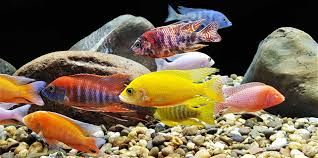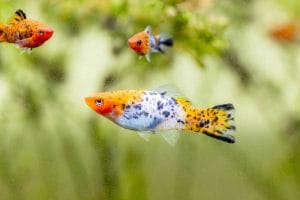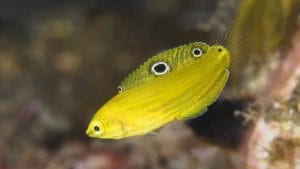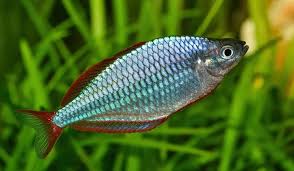
Discover the Most Common Freshwater Fish Species in Your Area

Are you an avid angler looking to improve your freshwater fish identification skills? Look no further than this comprehensive guide to identifying common freshwater fish species in your area.
With our tips and techniques, you can master the art of identifying freshwater fish based on their unique physical characteristics, such as body shape, fin structure, and color patterns.
Whether you’re a beginner or an experienced fisherman, this guide will provide you with the knowledge you need to successfully identify a wide variety of freshwater fish species.

Understanding Freshwater Fish Identification
Identifying freshwater fish can be both fascinating and challenging. Different fish species possess diverse physical features, such as coloration, body shape, and fin structure. These features can help you distinguish one fish species from another. In this section, we will discuss the essential factors to consider when identifying freshwater fish.
Body shape
The shape of a fish’s body can provide significant insight into its species. For example, trout usually have thin, streamlined bodies that are perfectly adapted for swimming in fast-moving currents. In contrast, catfish have broad, flat heads and bodies and a variability in shape. Observing body shape cues is a critical step in identifying freshwater fish.
Fin structure
Another essential feature to consider when identifying freshwater fish is the structure of the fins. The placement, shape, and number of fins can vary significantly by species. For example, perch have a single dorsal fin, while catfish have multiple dorsal fins. Observing these features can help you differentiate between two similar-looking fish.
Coloration and markings
The color and markings on a fish’s body are often the most obvious identifying characteristics. Rainbow trout, for example, have a unique pink stripe that runs down their sides. Other species, such as bass, have distinctive patterns that can help you identify them. Be sure to pay close attention to the color and markings on a fish’s body, as they can be essential in differentiating between similar species.
Identifying freshwater fish can be challenging, but by observing their body shape, fin structure, coloration, and markings, you can increase your chances of identifying them correctly.

Popular Freshwater Fish Species
Whether you’re a seasoned angler or a beginner, it’s essential to familiarize yourself with the freshwater fish species that are common in your local waters. Here are some of the most popular and frequently encountered freshwater fish:
| Fish Species | Common Names | Habitat | Distinctive Traits |
|---|---|---|---|
| Bass | Largemouth bass, smallmouth bass | Lakes, rivers, ponds | Large mouth and aggressive behavior |
| Trout | Brook trout, brown trout, rainbow trout | Rivers, streams, lakes | Colorful patterns and spots on the body |
| Walleye | Yellow pike-perch, walleyed pike | Lakes, rivers | Distinctive large eyes and sharp teeth |
| Pike | Northern pike, muskellunge | Lakes, rivers | Long and slender body, sharp teeth |
| Catfish | Channel catfish, blue catfish | Rivers, ponds | Whisker-like barbels around the mouth |
| Carp | Common carp, mirror carp | Rivers, lakes, ponds | Large scales, barbels around the mouth |
| Salmon | Chinook salmon, coho salmon | Rivers, lakes | Slender body, silver skin, and distinct spotted pattern |
| Sturgeon | White sturgeon, green sturgeon | Rivers, estuaries | Distinctive armor-like scales, long snout and four barbels |
By understanding the common names, habitats, and distinctive traits of these popular freshwater fish species, you can better identify and appreciate the fish you encounter while fishing.

Identifying Freshwater Fish through Visual Cues
When trying to identify a freshwater fish, there are certain visual cues that can be helpful. Factors such as body shape, fin structure, and coloration can all give clues to the species of fish you are looking at. Below are some key features to look out for when identifying freshwater fish:
- Body Shape: The shape of a fish’s body can be a great indicator of its species. For example, catfish have a flat, wide body, while trout have a more streamlined shape.
- Position of Fins: The position of a fish’s fins can also be a helpful identifier. Pay attention to the location and size of the dorsal, anal, and caudal fins.
- Coloration and Markings: Some freshwater fish have distinctive color patterns or markings that can be used to identify them. For example, largemouth bass have a dark, blotchy stripe running down their sides.
Here are some visual cues for identifying a few common freshwater fish species:
| Fish Species | Key Features |
|---|---|
| Bass | Large mouth, greenish-brown coloration with dark vertical stripes |
| Trout | Slender body, speckled coloration, small mouth with teeth |
| Catfish | Flat, wide body, smooth skin, barbels around mouth |
Remember that identifying fish takes practice and experience. Don’t be discouraged if you can’t identify a fish right away – keep observing and learning about the different species.
Common Freshwater Fish in Lakes
Lakes are home to a diverse range of freshwater fish species. If you are planning on fishing in a lake, it is important to know the common fish you may encounter. Here are some of the most popular lake fish and tips for identifying them:
| Fish | Tips for Identification |
|---|---|
| Bass | Typically green or brown, with a large mouth and spiny dorsal fin. |
| Trout | Slender in shape, with small scales and a forked tail. |
| Walleye | Golden-brown with spiny dorsal and anal fins and large, glassy eyes. |
| Pike | Long and slender, with a pointed head and sharp teeth. |
Of course, these are just a few examples of the many types of freshwater fish you may find in a lake. By familiarizing yourself with common species and their identifying features, you will be better equipped to identify them while fishing.

Common Freshwater Fish in Rivers
Rivers are dynamic environments that play host to a variety of freshwater fish species. Here are some of the most common fish you may encounter while fishing in rivers:
| Fish | Description |
|---|---|
| Catfish | Catfish are bottom-dwelling fish with distinctive whisker-like barbels around their mouths. They can grow quite large and are often sought after by anglers. |
| Carp | Carp are a type of freshwater fish that can often be seen near the surface of the water. They have a distinctive body shape with a deep, rounded belly and a downturned mouth. |
| Salmon | Salmon are known for their impressive migratory abilities, swimming upstream to spawn in the same spot where they were born. They have a streamlined body with silver scales and a pinkish-orange coloration. |
| Sturgeon | Sturgeon are ancient fish that can live for over 100 years. They have a distinctive, elongated body shape with five rows of bony plates along their sides. |
When identifying freshwater fish in rivers, it’s important to consider the specific characteristics of their habitat. For example, catfish are typically found in muddy or murky waters, while salmon often inhabit clearer, faster-moving streams and rivers.
When it comes to distinguishing between different types of fish, look for key features such as coloration, body shape, and fin placement. If you’re having trouble identifying a fish, try looking up images or descriptions online or consulting with a local fishing expert.

Common Freshwater Fish in Ponds
When it comes to fishing in ponds, there are several common freshwater fish species that anglers can target. These include bluegill, crappie, largemouth bass, and sunfish. Knowing how to identify these fish can help make your fishing experience more successful and enjoyable.
Bluegill are a popular panfish found in many ponds across the United States. They are typically light green or blue in color with a yellow or orange belly. Their bodies are flat and round, with small mouths that make them easy to catch using small bait such as worms or crickets.
Crappie are another popular panfish found in ponds. They have a silvery-gray or black body with distinctive black spots along their dorsal fin. They are often caught using small jigs or minnows.
Largemouth bass are a favorite among many anglers, and they can grow to be quite large in ponds that provide ample food and habitat. They have a greenish-brown body with a distinctive dark stripe that runs horizontally along their sides. Their mouths are large and can easily swallow larger bait such as live minnows or plastic worms.
Sunfish, which include species like pumpkinseed and bluegill, are often abundant in ponds. They have a similar body shape to bluegill, but with brighter colors and distinctive markings on their bodies, such as bright orange bellies and olive-green backs. They can be caught using small baits or lures such as spinners or jigs.
Overall, identifying common freshwater fish in ponds requires paying attention to their coloration, body shape, and distinctive markings. With a little practice, you’ll be able to identify and catch the fish you’re after in no time.

Protecting and Preserving Freshwater Fish Habitats
Freshwater fish habitats face numerous challenges, including pollution, overfishing, and climate change. It is crucial to protect and preserve their natural environments to ensure the survival of these important species.
Conservation Efforts
Conservation efforts are essential for preserving freshwater habitats and fish populations. Governments, conservation organizations, and individuals all play a role in protecting these environments. Some of the most common conservation efforts include:
- Creating and enforcing fishing regulations to prevent overfishing and the destruction of habitats
- Implementing water quality standards to reduce pollution and improve water quality
- Restoring damaged habitats through initiatives such as reforestation and streambank stabilization
- Engaging in scientific research to better understand freshwater ecosystems and identify threats to fish populations
By supporting these and other conservation efforts, we can help protect freshwater fish habitats and ensure their long-term survival.
Tips for Preserving Freshwater Fish Habitats
Individuals can take important steps to help preserve freshwater fish habitats. Some tips include:
- Properly disposing of trash and other waste to prevent pollution
- Avoiding the use of harmful chemicals, such as pesticides and fertilizers, that can harm aquatic life
- Conserving water to protect freshwater resources and reduce stress on habitats
- Supporting conservation organizations and advocacy efforts through donations and volunteer work
By taking these simple steps, we can all play a role in protecting the habitats of freshwater fish species.

Are Freshwater Crabs Compatible with Common Freshwater Fish Species?
Freshwater crabs can coexist with many common freshwater fish species, but it’s important to consider their specific care requirements. Providing hiding spots and aquarium space is vital for their well-being. Offering a varied diet that includes both animal and plant matter is crucial. Additionally, maintaining proper water parameters and checking for potential aggression between the crabs and fish are essential for a harmonious aquatic community. Following these freshwater crab care tips will maximize their compatibility with other fish species.
Frequently Asked Questions (FAQ) about Freshwater Fish Identification
At times, identifying freshwater fish can be a challenging task, especially for beginners. In this section, we have compiled a list of frequently asked questions that can help you overcome some common identification issues.
How do I identify a fish if I can’t see its color or markings?
If you cannot see the fish’s color or markings, there are other features you can observe to help you identify it. For example, you can focus on the fish’s body shape, size, fin structure, and the shape of its head or mouth. These features can give you a clue to the fish’s identity.
Can I use behavior to identify a fish?
Yes, observing a fish’s behavior can provide you with valuable identification clues. Different species exhibit distinct behaviors, such as feeding habits, swimming patterns, or interactions with other fish. By noting these behaviors, you can gain insights into the species you are observing.
What if I can’t get a good look at the fish before it swims away?
Sometimes, fish can be elusive, and it can be challenging to get a good look at them. If the fish swims away before you can identify it, try to recall any distinguishing features you observed, such as body shape or fin structure. These characteristics can help you narrow down the species you saw.
Are there any resources I can use to improve my freshwater fish identification skills?
Yes, there are several resources available to help you improve your freshwater fish identification skills. Field guides, websites, and social media groups dedicated to fishing and identification can provide you with valuable information and support. Additionally, taking a fishing course or workshop can also enhance your knowledge and skills.
How can I contribute to the conservation of freshwater fish habitats?
You can contribute to the conservation of freshwater fish habitats by reducing your impact on the environment. This can include properly disposing of trash, avoiding the use of harmful chemicals, and respecting fishing regulations and catch limits. Additionally, supporting organizations that work to protect and preserve freshwater habitats can also make a difference.
With these FAQs, we hope to have addressed some of the common challenges and questions related to freshwater fish identification. Remember to observe carefully, pay attention to detail, and use available resources to enhance your knowledge.






